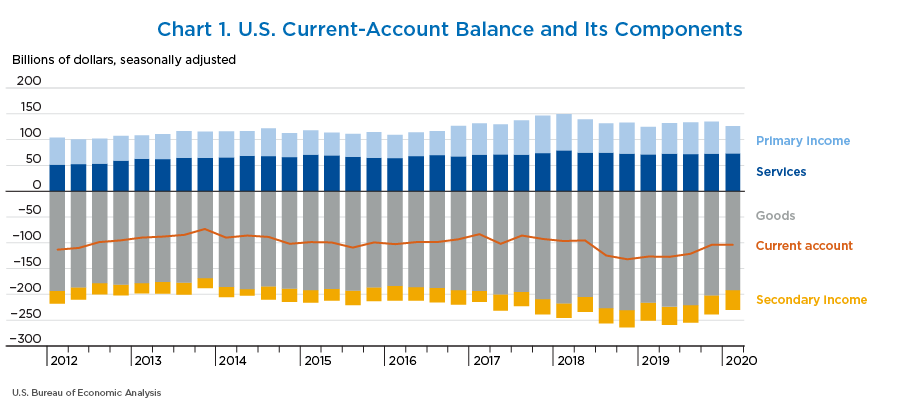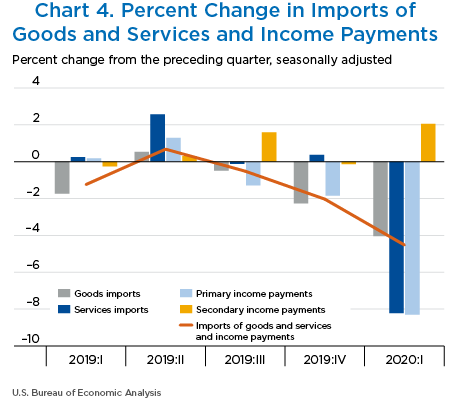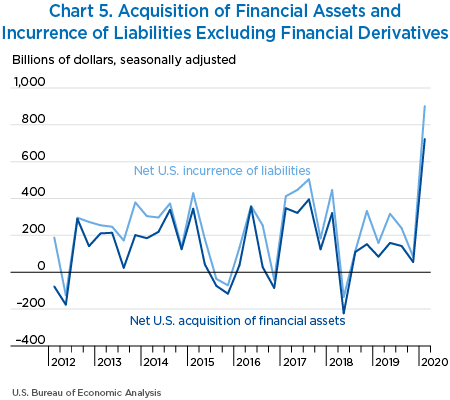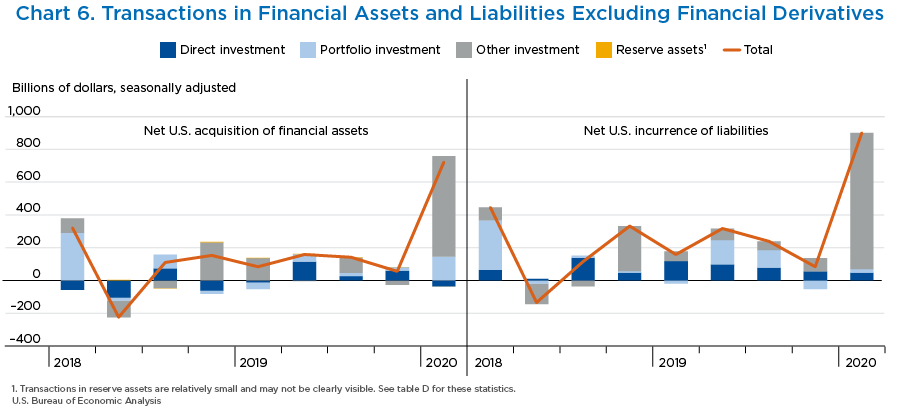U.S. International Transactions
First Quarter 2020
The U.S. current-account deficit, which reflects the combined balances on trade in goods and services and income flows between U.S. residents and residents of other countries, narrowed by $0.1 billion, or 0.1 percent, to $104.2 billion in the first quarter of 2020 (chart 1 and table A). The revised fourth-quarter deficit was $104.3 billion.
The first-quarter deficit was 1.9 percent of current-dollar gross domestic product, up less than 0.1 percentage point from the fourth quarter.
The $0.1 billion narrowing of the current-account deficit in the first quarter mainly reflected a reduced deficit on goods that was largely offset by a reduced surplus on primary income and an expanded deficit on secondary income.
| 2019 | 2020 | Change 2019:IV to 2020:I | |||
|---|---|---|---|---|---|
| II r | III r | IV r | I p | ||
| Current account | |||||
| Exports of goods and services and income receipts (credits) | 953,927 | 954,446 | 949,848 | 902,303 | −47,545 |
| Exports of goods and services | 631,394 | 630,189 | 632,469 | 612,382 | −20,087 |
| Goods | 411,069 | 410,930 | 411,390 | 402,960 | −8,430 |
| Services | 220,326 | 219,259 | 221,079 | 209,422 | −11,657 |
| Primary income receipts | 287,535 | 286,761 | 282,943 | 255,139 | −27,804 |
| Secondary income (current transfer) receipts | 34,997 | 37,496 | 34,435 | 34,781 | 346 |
| Imports of goods and services and income payments (debits) | 1,081,619 | 1,076,040 | 1,054,172 | 1,006,507 | −47,665 |
| Imports of goods and services | 783,605 | 779,847 | 762,228 | 731,437 | −30,791 |
| Goods | 635,641 | 632,059 | 613,887 | 595,291 | −18,596 |
| Services | 147,964 | 147,788 | 148,341 | 136,146 | −12,195 |
| Primary income payments | 228,069 | 225,140 | 220,985 | 202,652 | −18,333 |
| Secondary income (current transfer) payments | 69,945 | 71,053 | 70,959 | 72,419 | 1,460 |
| Capital account | |||||
| Capital transfer receipts and other credits | 4 | 15 | 6 | 6 | 0 |
| Capital transfer payments and other debits | 852 | 850 | 2,026 | 2,968 | 942 |
| Financial account | |||||
| Net U.S. acquisition of financial assets excluding financial derivatives (net increase in assets / financial outflow (+)) | 158,966 | 142,221 | 55,067 | 722,712 | 667,645 |
| Direct investment assets | 115,561 | 25,574 | 59,180 | −36,326 | −95,506 |
| Portfolio investment assets | 45,025 | 20,460 | 21,806 | 144,705 | 122,899 |
| Other investment assets | −3,980 | 94,305 | −26,128 | 614,578 | 640,706 |
| Reserve assets | 2,359 | 1,882 | 210 | −245 | −455 |
| Net U.S. incurrence of liabilities excluding financial derivatives (net increase in liabilities / financial inflow (+)) | 317,227 | 238,964 | 83,479 | 901,987 | 818,508 |
| Direct investment liabilities | 99,461 | 78,119 | 56,506 | 47,790 | −8,716 |
| Portfolio investment liabilities | 146,049 | 105,660 | −53,160 | 21,312 | 74,472 |
| Other investment liabilities | 71,717 | 55,185 | 80,133 | 832,885 | 752,752 |
| Financial derivatives other than reserves, net transactions | −9,642 | −6,382 | −933 | −21,830 | −20,897 |
| Statistical discrepancy | |||||
| Statistical discrepancy1 | −39,364 | 19,303 | 76,998 | −93,939 | −170,937 |
| Balances | |||||
| Balance on current account | −127,691 | −121,594 | −104,324 | −104,204 | 120 |
| Balance on goods and services | −152,210 | −149,658 | −129,759 | −119,055 | 10,704 |
| Balance on goods | −224,572 | −221,129 | −202,497 | −192,332 | 10,165 |
| Balance on services | 72,362 | 71,471 | 72,738 | 73,277 | 539 |
| Balance on primary income | 59,467 | 61,621 | 61,958 | 52,488 | −9,470 |
| Balance on secondary income | −34,948 | −33,556 | −36,524 | −37,637 | −1,113 |
| Balance on capital account | −848 | −835 | −2,019 | −2,962 | −943 |
| Net lending (+) or net borrowing (−) from current- and capital-account transactions2 | −128,539 | −122,429 | −106,344 | −107,166 | −822 |
| Net lending (+) or net borrowing (−) from financial-account transactions3 | −167,903 | −103,125 | −29,345 | −201,105 | −171,760 |
- p
- Preliminary
- r
- Revised
- The statistical discrepancy is the difference between net acquisition of financial assets and net incurrence of liabilities in the financial account (including financial derivatives) less the difference between total credits and total debits recorded in the current and capital accounts.
- Sum of current- and capital-account balances.
- Sum of net U.S. acquisition of financial assets and net transactions in financial derivatives less net U.S. incurrence of liabilities.
Note. The statistics are presented in International Transactions Accounts table 1.2 on BEA’s website.
Exports of goods and services to, and income received from, foreign residents decreased $47.5 billion to $902.3 billion in the first quarter (charts 2 and 3 and tables A and B). Imports of goods and services from, and income paid to, foreign residents decreased $47.7 billion to $1.01 trillion (charts 2 and 4 and tables A and C).
Trade in goods
Exports of goods decreased $8.4 billion to $403.0 billion, mostly reflecting decreases in capital goods, mainly civilian aircraft, and in consumer goods, mainly jewelry and collectibles. Imports of goods decreased $18.6 billion to $595.3 billion, mostly reflecting decreases in consumer goods, mainly cell phones and other household goods, and in capital goods, mainly computers, telecommunications equipment, and other industrial machinery.
Trade in services
Exports of services decreased $11.7 billion to $209.4 billion, and imports of services decreased $12.2 billion to $136.1 billion. The decreases in both exports and imports mainly reflected decreases in travel, primarily other personal travel, and in transport, primarily air passenger transport.
Primary income
Receipts of primary income decreased $27.8 billion to $255.1 billion, and payments of primary income decreased $18.3 billion to $202.7 billion. The decreases in both receipts and payments mostly reflected decreases in direct investment income, mainly earnings.
Secondary income
Receipts of secondary income increased $0.3 billion to $34.8 billion, and payments of secondary income increased $1.5 billion to $72.4 billion. The increases in both receipts and payments mainly reflected increases in private transfers, primarily private sector fines and penalties.
| 2019 | 2020 | Change 2019:IV to 2020:I | |||
|---|---|---|---|---|---|
| II r | III r | IV r | I p | ||
| Exports of goods and services and income receipts | 953,927 | 954,446 | 949,848 | 902,303 | −47,545 |
| Exports of goods | 411,069 | 410,930 | 411,390 | 402,960 | −8,430 |
| General merchandise | 406,812 | 405,848 | 405,687 | 398,096 | −7,591 |
| Foods, feeds, and beverages | 33,400 | 33,172 | 32,151 | 32,787 | 636 |
| Industrial supplies and materials | 132,140 | 129,780 | 132,804 | 133,847 | 1,043 |
| Energy products | 56,394 | 55,291 | 59,010 | 58,486 | −524 |
| Of which: Petroleum and products | 48,979 | 47,373 | 50,844 | 50,553 | −291 |
| Nonenergy products | 75,746 | 74,489 | 73,794 | 75,361 | 1,567 |
| Capital goods except automotive | 135,500 | 135,007 | 135,521 | 131,854 | −3,667 |
| Automotive vehicles, parts, and engines | 40,440 | 41,324 | 39,756 | 37,832 | −1,924 |
| Consumer goods except food and automotive | 51,200 | 51,462 | 49,797 | 46,983 | −2,814 |
| Other general merchandise | 14,133 | 15,102 | 15,657 | 14,793 | −864 |
| Net exports of goods under merchanting | 85 | 139 | 119 | 114 | −5 |
| Nonmonetary gold | 4,172 | 4,943 | 5,585 | 4,750 | −835 |
| Exports of services1 | 220,326 | 219,259 | 221,079 | 209,422 | −11,657 |
| Manufacturing services on physical inputs owned by others | n.a. | n.a. | n.a. | n.a. | n.a. |
| Maintenance and repair services n.i.e. | 6,651 | 7,088 | 7,432 | 7,428 | −4 |
| Transport | 22,930 | 22,333 | 22,693 | 20,295 | −2,398 |
| Travel (for all purposes including education) | 48,858 | 47,721 | 48,219 | 38,996 | −9,223 |
| Business | 9,466 | 9,107 | 9,368 | 7,330 | −2,038 |
| Personal | 39,392 | 38,613 | 38,852 | 31,666 | −7,186 |
| Construction | 761 | 849 | 734 | 705 | −29 |
| Insurance services | 4,036 | 4,260 | 3,762 | 3,593 | −169 |
| Financial services | 34,429 | 33,483 | 34,303 | 33,505 | −798 |
| Charges for the use of intellectual property n.i.e. | 29,223 | 29,237 | 29,993 | 29,792 | −201 |
| Telecommunications, computer, and information services | 14,328 | 14,267 | 14,306 | 14,825 | 519 |
| Other business services | 47,654 | 48,187 | 47,736 | 48,219 | 483 |
| Personal, cultural, and recreational services | 5,911 | 5,876 | 5,978 | 5,965 | −13 |
| Government goods and services n.i.e. | 5,546 | 5,959 | 5,924 | 6,100 | 176 |
| Primary income receipts | 287,535 | 286,761 | 282,943 | 255,139 | −27,804 |
| Investment income | 285,856 | 285,080 | 281,254 | 253,462 | −27,792 |
| Direct investment income | 145,837 | 144,810 | 146,363 | 120,607 | −25,756 |
| Income on equity | 139,282 | 138,192 | 140,194 | 114,799 | −25,395 |
| Dividends and withdrawals | 103,480 | 95,327 | 83,643 | 124,218 | 40,575 |
| Reinvested earnings | 35,802 | 42,865 | 56,551 | −9,419 | −65,970 |
| Interest | 6,555 | 6,618 | 6,168 | 5,809 | −359 |
| Portfolio investment income | 107,362 | 108,247 | 107,068 | 109,664 | 2,596 |
| Income on equity and investment fund shares | 72,633 | 73,190 | 72,083 | 74,911 | 2,828 |
| Interest on debt securities | 34,730 | 35,057 | 34,985 | 34,753 | −232 |
| Other investment income | 32,409 | 31,780 | 27,672 | 23,042 | −4,630 |
| Reserve asset income | 248 | 243 | 151 | 149 | −2 |
| Compensation of employees | 1,679 | 1,682 | 1,689 | 1,678 | −11 |
| Secondary income (current transfer) receipts2 | 34,997 | 37,496 | 34,435 | 34,781 | 346 |
- p
- Preliminary
- r
- Revised
- n.a.
- Not available
- n.i.e.
- Not included elsewhere
- See also International Services table 2.1.
- Secondary income (current transfer) receipts include U.S. government and private transfers, such as fines and penalties, withholding taxes, insurance-related transfers, and other current transfers.
| 2019 | 2020 | Change 2019:IV to 2020:I | |||
|---|---|---|---|---|---|
| II r | III r | IV r | I p | ||
| Imports of goods and services and income payments | 1,081,619 | 1,076,040 | 1,054,172 | 1,006,507 | −47,665 |
| Imports of goods | 635,641 | 632,059 | 613,887 | 595,291 | −18,596 |
| General merchandise | 633,703 | 628,870 | 609,144 | 589,096 | −20,048 |
| Foods, feeds, and beverages | 38,349 | 38,328 | 37,398 | 38,673 | 1,275 |
| Industrial supplies and materials | 135,439 | 129,899 | 126,630 | 121,677 | −4,953 |
| Energy products | 59,727 | 54,163 | 53,410 | 48,302 | −5,108 |
| Of which: Petroleum and products | 56,283 | 50,903 | 49,775 | 45,565 | −4,210 |
| Nonenergy products | 75,712 | 75,736 | 73,220 | 73,375 | 155 |
| Capital goods except automotive | 170,460 | 169,509 | 168,127 | 161,779 | −6,348 |
| Automotive vehicles, parts, and engines | 96,200 | 95,356 | 89,707 | 87,846 | −1,861 |
| Consumer goods except food and automotive | 165,095 | 167,021 | 157,381 | 150,663 | −6,718 |
| Other general merchandise | 28,159 | 28,757 | 29,901 | 28,458 | −1,443 |
| Nonmonetary gold | 1,938 | 3,189 | 4,743 | 6,196 | 1,453 |
| Imports of services1 | 147,964 | 147,788 | 148,341 | 136,146 | −12,195 |
| Manufacturing services on physical inputs owned by others | n.a. | n.a. | n.a. | n.a. | n.a. |
| Maintenance and repair services n.i.e. | 1,963 | 1,941 | 1,949 | 1,924 | −25 |
| Transport | 26,892 | 26,668 | 26,570 | 22,720 | −3,850 |
| Travel (for all purposes including education) | 34,668 | 33,151 | 33,717 | 24,853 | −8,864 |
| Business | 4,893 | 4,685 | 4,609 | 3,140 | −1,469 |
| Personal | 29,775 | 28,466 | 29,108 | 21,714 | −7,394 |
| Construction | 327 | 330 | 321 | 321 | 0 |
| Insurance services | 12,880 | 13,403 | 13,954 | 14,418 | 464 |
| Financial services | 10,206 | 10,157 | 10,010 | 10,143 | 133 |
| Charges for the use of intellectual property n.i.e. | 10,448 | 10,631 | 10,587 | 9,982 | −605 |
| Telecommunications, computer, and information services | 11,029 | 10,982 | 11,088 | 11,133 | 45 |
| Other business services | 28,310 | 29,171 | 28,550 | 28,889 | 339 |
| Personal, cultural, and recreational services | 5,278 | 5,249 | 5,483 | 5,649 | 166 |
| Government goods and services n.i.e. | 5,962 | 6,105 | 6,113 | 6,114 | 1 |
| Primary income payments | 228,069 | 225,140 | 220,985 | 202,652 | −18,333 |
| Investment income | 223,413 | 220,430 | 216,145 | 198,001 | −18,144 |
| Direct investment income | 63,876 | 60,941 | 61,104 | 46,249 | −14,855 |
| Portfolio investment income | 123,759 | 124,526 | 124,328 | 124,926 | 598 |
| Income on equity and investment fund shares | 42,610 | 42,401 | 41,897 | 45,334 | 3,437 |
| Interest on debt securities | 81,149 | 82,125 | 82,431 | 79,592 | −2,839 |
| Other investment income | 35,778 | 34,963 | 30,713 | 26,827 | −3,886 |
| Compensation of employees | 4,656 | 4,711 | 4,840 | 4,651 | −189 |
| Secondary income (current transfer) payments2 | 69,945 | 71,053 | 70,959 | 72,419 | 1,460 |
| Supplemental detail on insurance transactions: | |||||
| Premiums paid | 32,167 | 32,787 | 33,042 | 33,351 | 309 |
| Losses recovered | 18,996 | 19,075 | 19,351 | 19,163 | −188 |
- p
- Preliminary
- r
- Revised
- n.a.
- Not available
- n.i.e.
- Not included elsewhere
- See also International Services table 2.1.
- Secondary income (current transfer) payments include U.S. government and private transfers, such as U.S. government grants and pensions, fines and penalties, withholding taxes, personal transfers (remittances), insurance-related transfers, and other current transfers.
Capital transfer payments increased $0.9 billion to $3.0 billion in the first quarter, primarily reflecting an increase in investment grants (table A).
Net financial-account transactions were −$201.1 billion in the first quarter, reflecting net U.S. borrowing from foreign residents.
Financial assets
First-quarter transactions increased U.S. residents' foreign financial assets by $722.7 billion (charts 5 and 6 and table D). Transactions increased portfolio investment assets by $144.7 billion, resulting from large and partly offsetting transactions in equity securities and debt securities, and other investment assets, mostly currency and deposits, by $614.6 billion. Transactions in deposits included $353.9 billion in foreign currency acquired by the Federal Reserve System from central bank liquidity swaps with foreign central banks. Transactions decreased direct investment assets, mostly debt instruments, by $36.3 billion, and reserve assets by $0.2 billion.
Liabilities
First-quarter transactions increased U.S. liabilities to foreign residents by $902.0 billion. Transactions increased direct investment liabilities, mainly equity, by $47.8 billion; portfolio investment liabilities by $21.3 billion, resulting from large and mostly offsetting transactions in equity securities and debt securities; and other investment liabilities, mostly currency and deposits and loans, by $832.9 billion. Transactions in deposits included $387.3 billion in interbank deposits received by the U.S. branches of foreign banks from affiliated foreign banks. These were mainly the U.S. dollars that foreign central banks obtained through the swaps described in the assets section above, which they then lent to foreign banks.
Financial derivatives
Net transactions in financial derivatives were −$21.8 billion in the first quarter, reflecting net borrowing from foreign residents.
| 2019 | 2020 | Change 2019:IV to 2020:I | |||
|---|---|---|---|---|---|
| II r | III r | IV r | I p | ||
| Net U.S. acquisition of financial assets excluding financial derivatives (net increase in assets / financial outflow (+)) | 158,966 | 142,221 | 55,067 | 722,712 | 667,645 |
| Direct investment assets | 115,561 | 25,574 | 59,180 | −36,326 | −95,506 |
| Equity | 43,942 | 45,886 | 55,296 | −3,804 | −59,100 |
| Equity other than reinvestment of earnings | 8,140 | 3,021 | −1,255 | 5,615 | 6,870 |
| Reinvestment of earnings | 35,802 | 42,865 | 56,551 | −9,419 | −65,970 |
| Debt instruments | 71,619 | −20,312 | 3,884 | −32,522 | −36,406 |
| Portfolio investment assets | 45,025 | 20,460 | 21,806 | 144,705 | 122,899 |
| Equity and investment fund shares | −14,209 | −56,839 | −99,715 | 306,370 | 406,085 |
| Debt securities | 59,234 | 77,299 | 121,521 | −161,665 | −283,186 |
| Short-term securities | 23,399 | 61,443 | 66,150 | −62,295 | −128,445 |
| Long-term corporate securities | 24,996 | 7,841 | 35,418 | −76,131 | −111,549 |
| Other long-term securities | 10,839 | 8,015 | 19,953 | −23,239 | −43,192 |
| Other investment assets | −3,980 | 94,305 | −26,128 | 614,578 | 640,706 |
| Other equity | 1,349 | 18 | 0 | 1,298 | 1,298 |
| Currency and deposits | 37,028 | 16,306 | 66,347 | 439,758 | 373,411 |
| Loans | −41,481 | 73,336 | −91,595 | 178,144 | 269,739 |
| Trade credit and advances | −875 | 4,645 | −879 | −4,622 | −3,743 |
| Reserve assets | 2,359 | 1,882 | 210 | −245 | −455 |
| Monetary gold | 0 | 0 | 0 | 0 | 0 |
| Special drawing rights | 60 | 63 | 57 | 49 | −8 |
| Reserve position in the International Monetary Fund | 2,248 | 1,754 | 155 | −327 | −482 |
| Other reserve assets | 51 | 64 | −2 | 33 | 35 |
| Net U.S. incurrence of liabilities excluding financial derivatives (net increase in liabilities / financial inflow (+)) | 317,227 | 238,964 | 83,479 | 901,987 | 818,508 |
| Direct investment liabilities | 99,461 | 78,119 | 56,506 | 47,790 | −8,716 |
| Equity | 72,720 | 53,158 | 78,529 | 57,521 | −21,008 |
| Equity other than reinvestment of earnings | 32,858 | 17,832 | 46,367 | 35,717 | −10,650 |
| Reinvestment of earnings | 39,861 | 35,326 | 32,161 | 21,803 | −10,358 |
| Debt instruments | 26,742 | 24,961 | −22,023 | −9,730 | 12,293 |
| Portfolio investment liabilities | 146,049 | 105,660 | −53,160 | 21,312 | 74,472 |
| Equity and investment fund shares | 86,874 | −42,481 | −72,736 | 270,997 | 343,733 |
| Debt securities | 59,174 | 148,141 | 19,576 | −249,685 | −269,261 |
| Short term | −71,238 | 60,400 | −48,444 | −10,669 | 37,775 |
| Treasury bills and certificates | −57,630 | 42,275 | −43,855 | 13,391 | 57,246 |
| Federally sponsored agency securities | −73 | −748 | 5,493 | −4,708 | −10,201 |
| Other short-term securities | −13,535 | 18,873 | −10,082 | −19,352 | −9,270 |
| Long term | 130,413 | 87,741 | 68,020 | −239,015 | −307,035 |
| Treasury bonds and notes | 93,996 | 32,139 | 19,117 | −275,707 | −294,824 |
| Federally sponsored agency securities | 20,390 | 10,507 | 5,067 | 54,628 | 49,561 |
| Corporate bonds and notes | 18,204 | 44,514 | 43,267 | −16,560 | −59,827 |
| Other | −2,177 | 581 | 569 | −1,376 | −1,945 |
| Other investment liabilities | 71,717 | 55,185 | 80,133 | 832,885 | 752,752 |
| Other equity | n.a. | n.a. | n.a. | n.a. | n.a |
| Currency | 9,356 | 19,110 | 17,579 | 26,014 | 8,435 |
| Deposits | 104,374 | 74,616 | 3,075 | 480,067 | 476,992 |
| Loans | −42,741 | −37,372 | 56,253 | 322,996 | 266,743 |
| Trade credit and advances | 729 | −1,169 | 3,226 | 3,808 | 582 |
| Special drawing rights allocations | 0 | 0 | 0 | 0 | 0 |
- p
- Preliminary
- r
- Revised
- n.a.
- Not available
The U.S. international transactions statistics for the first quarter of 1999 through the fourth quarter of 2019 have been updated to incorporate newly available and revised source data, improved estimation methodologies, updated seasonal adjustments, and changes in classifications and definitions (table E). In addition, table presentations for the International Transactions Accounts have been expanded to provide additional detail.
For more information, see Rudy Telles Jr., Nick Martinez, and Ted Peck, “Annual Update of the International Transactions Accounts,” in this issue of the Survey of Current Business.
| Preliminary Estimates | Revised Estimates | |
|---|---|---|
| Balance on current account | −109,822 | −104,324 |
| Balance on goods | −202,784 | −202,497 |
| Balance on services | 62,930 | 72,738 |
| Balance on primary income | 67,283 | 61,958 |
| Balance on secondary income (current transfers) | −37,251 | −36,524 |
| Net lending or borrowing from financial-account transactions | −71,790 | −29,345 |
| Net U.S. acquisition of financial assets | 998 | 55,067 |
| Net U.S. incurrence of liabilities | 71,855 | 83,479 |
| Financial derivatives other than reserves, net transactions | −933 | −933 |





